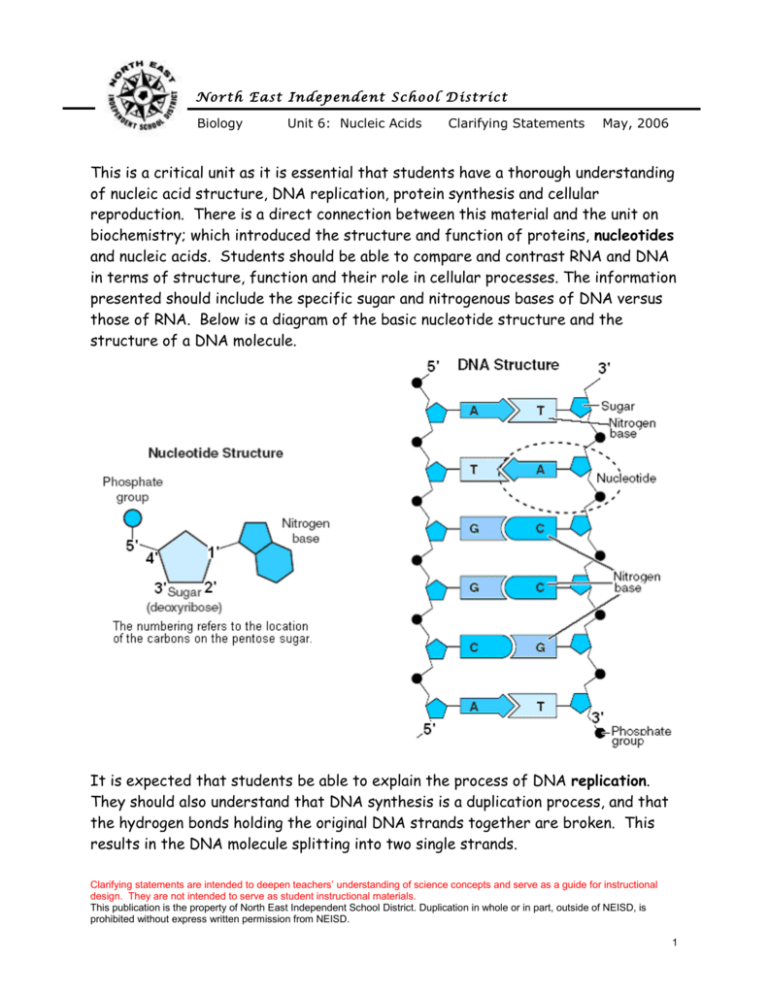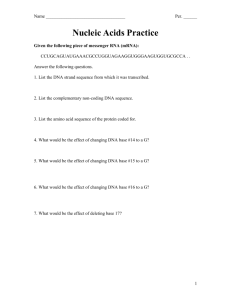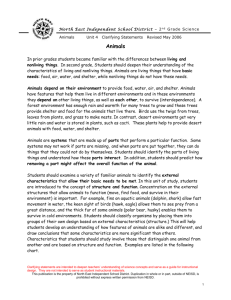Nucleic Acids - North East Independent School District
advertisement

N o r t h E a st I n d ep en d e nt S c h o o l D i st ric t Biology Unit 6: Nucleic Acids Clarifying Statements May, 2006 This is a critical unit as it is essential that students have a thorough understanding of nucleic acid structure, DNA replication, protein synthesis and cellular reproduction. There is a direct connection between this material and the unit on biochemistry; which introduced the structure and function of proteins, nucleotides and nucleic acids. Students should be able to compare and contrast RNA and DNA in terms of structure, function and their role in cellular processes. The information presented should include the specific sugar and nitrogenous bases of DNA versus those of RNA. Below is a diagram of the basic nucleotide structure and the structure of a DNA molecule. It is expected that students be able to explain the process of DNA replication. They should also understand that DNA synthesis is a duplication process, and that the hydrogen bonds holding the original DNA strands together are broken. This results in the DNA molecule splitting into two single strands. Clarifying statements are intended to deepen teachers’ understanding of science concepts and serve as a guide for instructional design. They are not intended to serve as student instructional materials. This publication is the property of North East Independent School District. Duplication in whole or in part, outside of NEISD, is prohibited without express written permission from NEISD. 1 N o r t h E a st I n d ep en d e nt S c h o o l D i st ric t Biology Unit 6: Nucleic Acids Clarifying Statements May, 2006 Below is diagram of DNA replication. Students should recognize that an enzyme is used to base pair new DNA nucleotides to the original DNA template. If time permits, students may be introduced to the concept that DNA has polarity in terms of the 5’ and 3’ ends. Students should also be aware that errors can occur when an enzyme pairs an incorrect nitrogenous base to the template. It should also be explained that errors are corrected by repair enzymes, and that incorrect pairings that are not corrected become mutations. When presented with a single DNA strand, students should be able to identify its complementary strand. For example, if students are given the DNA sequence , they should be able to identify the complementary strand as . Once DNA replication is explained, students should then be able to explain the cell cycle and the process of mitosis. It is crucial that students understand that two genetically identical daughter cells are produced as a result of mitosis, and that this is an example of asexual reproduction. The students should be able to contrast this process with meiosis, which is a form of sexual reproduction. Students should recognize that during meiosis four haploid gametes are produced from a diploid cell in either the ovaries or testis. This process results in cells with Clarifying statements are intended to deepen teachers’ understanding of science concepts and serve as a guide for instructional design. They are not intended to serve as student instructional materials. This publication is the property of North East Independent School District. Duplication in whole or in part, outside of NEISD, is prohibited without express written permission from NEISD. 2 N o r t h E a st I n d ep en d e nt S c h o o l D i st ric t Biology Unit 6: Nucleic Acids Clarifying Statements May, 2006 half the normal number of chromosomes. During meiosis genes are shuffled, producing gamete diversity. The process of meiosis is crucial to understanding genetics, the focus of the next unit. Students should be able to compare and contrast mitosis and meiosis in terms of the structure and function of the cells produced. Laboratory activities that can supplement this material include examining root tips and white fish blastulas. Modeling the process of mitosis and meiosis can also help students visualize the differences between the two processes. It is important that students have a complete understanding of protein synthesis, which is an essential cellular process. Students should be able explain the concept of a gene as a sequence of DNA nucleotides that directs the synthesis of a protein. There is a direct relation of this material to the unit on biochemistry; therefore students should be reminded of the many functions of proteins and their role in living organisms. It is important that they are also aware that a chromosome contains thousands of genes. Students should know that there are two major components of protein synthesis; transcription and translation. The initial process of protein synthesis is transcription, where the DNA nucleotides of a gene are used as a template to make an intermediate molecule, or RNA. Students should know that an enzyme is involved in the base pairing of RNA nucleotides to the DNA gene or template. Students should be given opportunities to determine the correct mRNA sequence that would be synthesized by a given DNA gene or sequence. For example when given the mRNA sequence, below, students should recognize that it was transcribed from the DNA sequence ACT AAG. Once transcription is complete, students should know that the mRNA is transported from the nucleus out to the cytoplasm, initiating the process of translation. Clarifying statements are intended to deepen teachers’ understanding of science concepts and serve as a guide for instructional design. They are not intended to serve as student instructional materials. This publication is the property of North East Independent School District. Duplication in whole or in part, outside of NEISD, is prohibited without express written permission from NEISD. 3 N o r t h E a st I n d ep en d e nt S c h o o l D i st ric t Biology Unit 6: Nucleic Acids Clarifying Statements May, 2006 The second component of protein synthesis is translation, which involves the actual synthesis of a polypeptide chain. Given a specific diagram, students should be able to recognize the material needed in translation (such as mRNA, tRNA, amino acids and ribosomes). Below is an example of a translation diagram. It is essential that students understand the concept of a codon and how to use a codon chart to determine the correct sequence of a polypeptide chain from a specific mRNA sequence. For example, students must to be able to use a partial codon chart, such as the one below, to evaluate what happens if an mRNA codon changes from UAC to UCC. In this instance, the change results in a substitution of the amino acid serine for tyrosine. A more serious change would result however if the mRNA codon changes from UAC to UAG. Instead of creating a substitution, this polypeptide chain would be terminated by stop codon. The students should be aware that there are changes that do not alter the polypeptide at all. For instance, if the UAC codon had been changed to UAA, the amino acid would have remained tyrosine. Students must be able to classify these changes as frame shift or point mutations. Clarifying statements are intended to deepen teachers’ understanding of science concepts and serve as a guide for instructional design. They are not intended to serve as student instructional materials. This publication is the property of North East Independent School District. Duplication in whole or in part, outside of NEISD, is prohibited without express written permission from NEISD. 4 N o r t h E a st I n d ep en d e nt S c h o o l D i st ric t Biology Unit 6: Nucleic Acids Clarifying Statements May, 2006 Students must understand the concept of anticodons found on tRNA and their significance in transporting the correct amino acid to the mRNA codon on the ribosome. Students should also know how amino acids are bonded together in the formation of a polypeptide chain. This is a foundational unit and is critical to understanding the following unit on genetics. Students can expect several questions on the TAKS exam that are based on the material of this unit. Clarifying statements are intended to deepen teachers’ understanding of science concepts and serve as a guide for instructional design. They are not intended to serve as student instructional materials. This publication is the property of North East Independent School District. Duplication in whole or in part, outside of NEISD, is prohibited without express written permission from NEISD. 5







